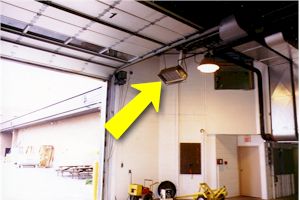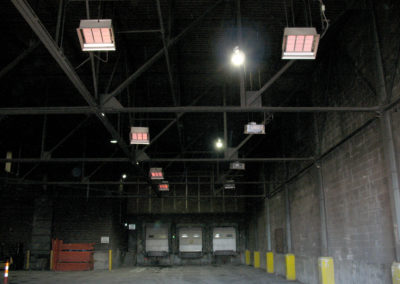Aircraft Hangars
 Equipment Selection
Equipment Selection
High BTU tube heaters and/or high BTU, high intensity infrared models are preferred for high-mount locations like hangars. Two stage infrared heaters are highly recommended. They recover heat lost through large doors, yet cycle less frequently during normal operation.
Installation
Most of the heat should be concentrated near the main door by locating burner boxes or additional heaters at this point. It is important to note that ANSI/NFPA 409 calls for the heater to be installed at least 10 feet above the highest wing surface of any aircraft stored inside.
Auto Body Shops
Equipment Selection
Depending on mounting height requirements, a full range of infrared heater models is available for application into auto service centers. Tube heaters (75,000-150,000 BTU’s) are most commonly applied, but also popular are high intensity IR Heaters (30,000-90,000 BTU’s). Negative pressure vacuum systems are usually prohibitive due to size and cost constraints. The RHT Series provides faster heat recoveries as doors are opened and closed. Heaters are thermostatically controlled and very often interlocked with ventilation if using the unvented IR Series.

Installation
Apply the heaters on a perimeter mounted design when applicable. Stack the door areas with extra units, or locate tube burner boxes there to provide extra heat. Take care to avoid violating the published clearances to combustibles with doors in the open position and/or lifts (with cars on them) in the up position. Common applications also utilize tubes located between lift rows (center of the building) or alongside a wall with the heat shined inward. Outside combustion air is highly recommended. Lastly, do not place any heater inside of a paint booth.
Fire Stations
Equipment Selection
 Preferred equipment would be two stage, low intensity, mid-range BTU, infrared tube heater. The use of infrared tube heaters allows for lower mounting heights, reduces possible issues with clearances to combustibles , and they can be vented. The use of two stage equipment allows for fast recovery time when the doors are opened or when the trucks return from a call. Equipment to avoid would be a vacuum system due to noise issues and extra costs. Also, one must carefully review mounting heights and ventilation issues prior to selecting high intensity heaters.
Preferred equipment would be two stage, low intensity, mid-range BTU, infrared tube heater. The use of infrared tube heaters allows for lower mounting heights, reduces possible issues with clearances to combustibles , and they can be vented. The use of two stage equipment allows for fast recovery time when the doors are opened or when the trucks return from a call. Equipment to avoid would be a vacuum system due to noise issues and extra costs. Also, one must carefully review mounting heights and ventilation issues prior to selecting high intensity heaters.
Installation
The placement of all burner boxes should be with the burner end closest to the truck doors. Heaters should be placed between parking rows so that no truck may be parked below it. Side shields may also be needed. If an apparatus bay exceeds 60 ft., or if there are doors at both ends, dual common vented heaters are suggested. Thermostat location should be on a common wall, mid-range of the heater.
Hockey Rinks
Equipment Selection

Most often, the seating area around the ice will be heated, with care taken not to allow infrared rays to hit the ice surface. “Spot heating” type models (short tubes or high intensity infrared heaters) are best to focus heat where needed. Care should be taken when applying long tube heaters (50 ft. or more), vacuum systems, or very high BTU high intensity heaters (more than 90,000 BTUs).
Installation
Heaters are placed 10 ft. or more above the seats and located 5-7 ft. in from the ice surface. Most often, heaters are angled towards the sitting area, away from the ice. Typical reflector mounting angle is 15° to 30°. Side shields should be used if necessary. Place the heaters so that a burner is located to provide optimal and even coverage. Heaters are typically vented through the roof. Outside combustion air is optional.
Loading Docks
Equipment Selection

 U-tube heaters, short length high BTU infrared tube heaters, and IR Series are preferred. Two stage heaters will significantly improve recovery time after doors are opened and closed. The IR Series can be equally effective, provided that ventilation and clearances to combustibles are addressed. Control is usually by a thermostat. Because of wind, millivolt controls are not recommended on IR Heaters.
U-tube heaters, short length high BTU infrared tube heaters, and IR Series are preferred. Two stage heaters will significantly improve recovery time after doors are opened and closed. The IR Series can be equally effective, provided that ventilation and clearances to combustibles are addressed. Control is usually by a thermostat. Because of wind, millivolt controls are not recommended on IR Heaters.
Installation
Position tube heaters so that burner boxes are mounted as close to doors as possible. Using “U” tube heaters doubles the amount of heat available within a given area.
Avoid parking vehicles directly under tube heaters by mounting between door columns. To avoid scorching doors, avoid placing heaters too close to door tracks. When using IR heaters, try to place 60-90,000 BTU models between the door columns, facing toward the inside at the specified mounting angle.
Manufacturing
Equipment Selection
 Almost all types of infrared heaters are applied in manufacturing environments. Very often, a combination of tubes and high-intensity IR heaters is best suited for complete and spot heating within a manufacturing plant. When selecting equipment for manufacturing facilities, the fundamental application rules of infrared should be followed, and a professional should be contacted to discuss the application.
Almost all types of infrared heaters are applied in manufacturing environments. Very often, a combination of tubes and high-intensity IR heaters is best suited for complete and spot heating within a manufacturing plant. When selecting equipment for manufacturing facilities, the fundamental application rules of infrared should be followed, and a professional should be contacted to discuss the application.
Installation
Because of enormous differences in size from facility to facility, it is difficult to specify absolute guidelines. However, many manufacturing environments have common situations, some of which are:
– Overhead cranes (heaters are usually placed under rails).
– Sprinkler systems (verify clearances).
– Dirty environments (use tube heaters with outside combustion air).
– High mounting locations (use larger models).
– Overhead doors and loading docks (extra heat).
– High storage areas (install signs to maintain clearance from combustibles).
– Effective coverage (perimeter mounting).
Warehouses
Equipment Selection
 A wide variety of equipment options are available for heating a warehouse environment. The type of warehouse, size, mounting heights, and other obstacles must be considered. Tube type heaters offer more options for heater placement with regard to clearances to combustibles. Heaters are typically thermostatically controlled.
A wide variety of equipment options are available for heating a warehouse environment. The type of warehouse, size, mounting heights, and other obstacles must be considered. Tube type heaters offer more options for heater placement with regard to clearances to combustibles. Heaters are typically thermostatically controlled.
Installation
Heaters are strategically placed within a warehouse for optimum coverage of space. This may be a perimeter-mounted system or a series of heaters between rows of storage racks. Clearances to combustibles must be considered carefully. This is true for both top clearances and lower clearances, which are of concern when stacking combustible items. It is recommended that warning plaques (P/N: PLQ) be mounted to advise users of clearances to combustibles and stacking limits.





 Sample Drawing #2
Sample Drawing #2